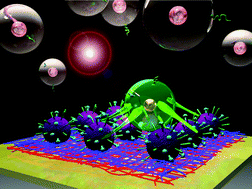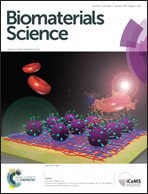A biomimetic approach to hormone resistant prostate cancer cell isolation using inactivated Sendai virus (HVJ-E)†
Abstract
Our study reports a versatile immobilization method of Hemagglutinating Virus of Japan Envelope (HVJ-E) for the generation of viral-mimetic surfaces for hormone resistant prostate cancer cell isolation. HVJ-E has recently attracted much attention as a new type of therapeutic material because hormone resistant prostate cancer cells such as PC-3 cells possess the HVJ-E receptors, GD1a. The HVJ-E was successfully immobilized on precursor films composed of poly-L-lysine and alginic acid via layer-by-layer assembly without changing the biological activity. The monolayer adsorption of HVJ-E particles was confirmed by quartz crystal microbalance, fluorescent and atomic force microscopy analyses. By developing the HVJ-E coating with an affinity based cell trap within a glass capillary tube, we are able to gently isolate PC-3 from LN-Cap cells that represent adenocarcinoma without compromising cell viability. We achieved approximately 100% cell separation efficiency only by 60 seconds of flowing. We believe that the proposed technique offers significant promise for the creation of a hormone resistant cancer cell trap on a broad range of materials.


 Please wait while we load your content...
Please wait while we load your content...